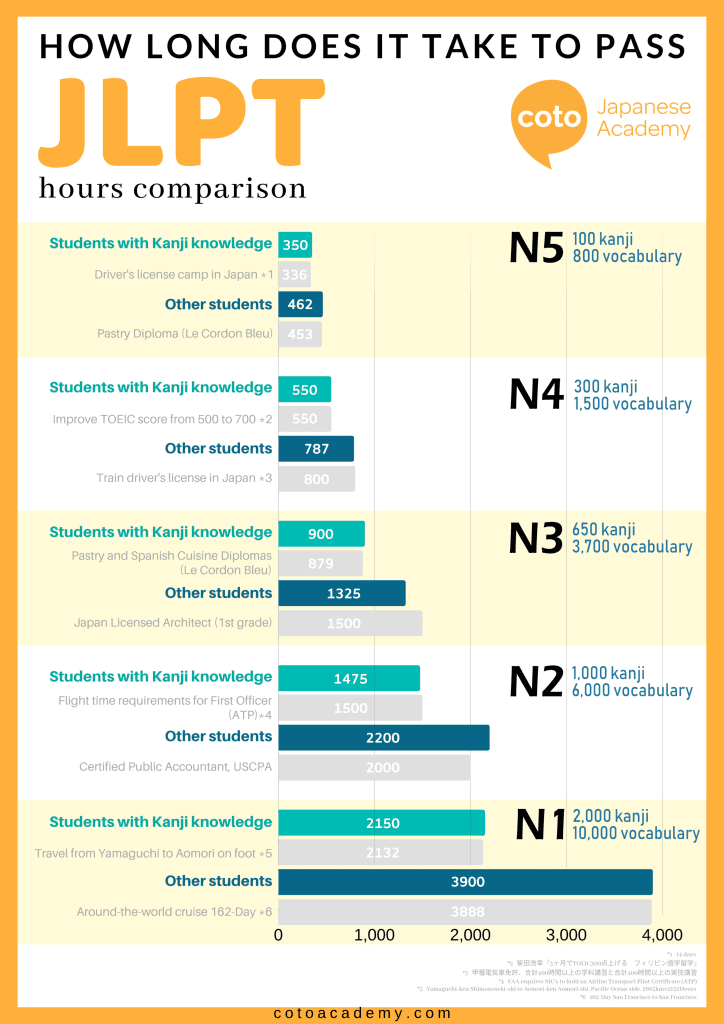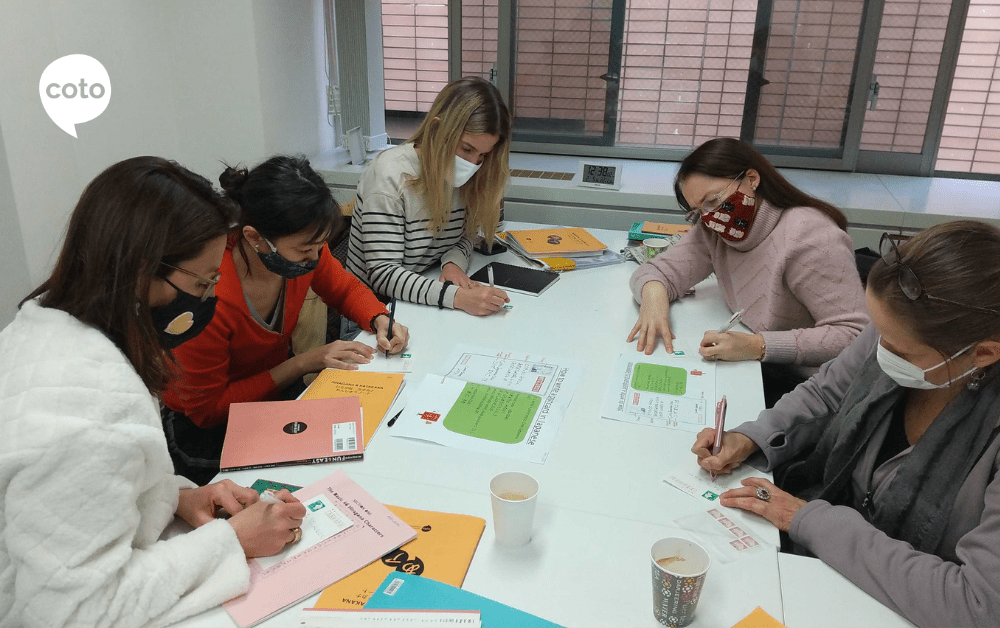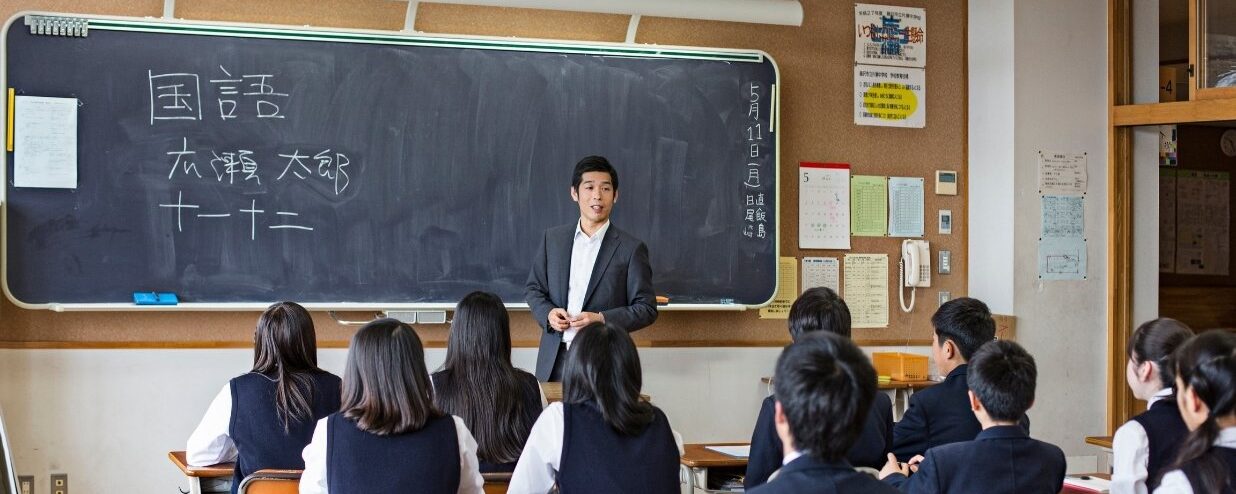If you have started learning Japanese or thinking about doing it soon, you might ask yourself: How long does it take to learn Japanese? It’s an honest question, and probably the most important. Between people’s fascination with Japanese culture and the desire to live in Japan, Japanese has become one of the most popular languages to learn – but also the hardest, too.
The answer to this question is, “it depends”. Understandably, no one likes to hear that — but it’s an honest answer because there’s no one-size-fits-all when it comes to how long it takes to learn Japanese. The factors that affect how long you’ll get to your goal include your prior language experience, learning style, motivation, and dedication
That’s why we see a lot of people who seem to be passing JLPT N2 or N2 effortlessly, while others re-taking N5 or N4 tests.
In this response, we’ll explore the different factors that can impact the time it takes to learn Japanese and provide some estimates on how long it may take for a beginner to become proficient in the language.
Defining Fluency in Japanese Language Learning
To the majority, language fluency is a spectrum. You can talk to your Japanese friends in casual Japanese and call it fluent. You might think that to be one means being able to lead a meeting with your coworkers in full keigo.
A good rule of thumb is if you find yourself constantly translating between Japanese and your own native language and forming sentences quickly, you’d be hard-pressed to describe yourself as fluent. In its academic definition made by Dr. Paul Nation and Asuza Yamamoto, fluency is ‘being able to receive and produce language at a reasonable rate’. You should ask yourself, “Am I at ease when I speak Japanese? Do I get constantly worried about the next question from my partner?”
On the other hand, this number begs the question: Can I call myself fluent if I am able to watch anime without subtitles? Talk to your Japanese friends without any fillers like eto or ano? Or write a foolproof business email to your Japanese boss?
Remember that there’s more to communication than speaking and listening! There are also four aspects that make up Japanese language fluency: speaking, listening, reading, and writing. You may be excellent at conversing in Japanese, but barely able to write a single kanji.
So depending on how you define fluency, you might get to that point faster or slower! And don’t worry: we’ve broken down the study hours based on your goal and the desired level below.
How Long Does it Take to Learn Japanese Based On Your Goal?
The FSI of the US State Department estimates that it takes 88 weeks, or 2,200 study hours, to reach what most people define as Japanese fluency. This is probably a fairer assessment than saying it takes 2 years to speak Japanese. The more hours you put to practice Japanese in a day or stay consistent throughout the week, the faster you’ll learn.
Ultimately, achieving a high level in Japanese takes time, as with other languages. A lot of people who live in Japan and studied the language for years might still say they have a long way to go, so you can’t expect instant results in a matter of weeks.
As a reference, we’ve broken down how long it takes to learn Japanese based on what you’re using the language for. Depending on your goal, you might want to focus on one language aspect (like speaking) more than the other.
| Goal | How you’ll use Japanese | Study Hours |
| Travel | Ask for directions, order food, and make basic greetings. | 7 – 30 days |
| Make friends | Daily conversations, expressing thoughts and opinions, holding natural conversations in a wider range of circumstances. | 900-1,300 study hours (6 months – 1 year) |
| Work part-time job in Japan | Speak basic keigo to customers, interact with Japanese coworkers | 900-1,300 study hours (6 months – 1 year) |
| Get a job in Japan | Use keigo (Japanese honorifics), business Japanese, manners and cultural awareness, JLPT (N2 or N1) | 2,000 – 4,000 study hours (2 years) |
| Go to university | Take the EJU (Japanese entrance examination, and JLPT (N2 or N1), take Japanese tests, make a presentation | 2,000 – 3,000 study hours (2 years) |
How Many Hours a Day You Should Study Japanese
You might notice we’ve been using “study hours” instead of exact days or months, which can be frustrating if you want a straightforward answer on how long it takes to learn Japanese.
Days and months can vary in length and can be influenced by external factors, such as holidays or personal schedules, making it difficult to accurately track progress. There are people who might study 30 minutes a day. Some dedicate 3 hours a day, while a few people spend 6-7 hours studying full-time. This isn’t the best-standardized unit of time.
If you are learning as a hobby, dedicating 15 to 30 minutes a day to studying is fine. In 6 months, you’ll be able to read basic texts and hold limited conversations.
Most people recommend studying for 3 to 4 hours every day on a set schedule allows your brain to work at its full capacity and avoid burnout. Even intensive courses at Coto Academy and Japanese language classes at other Japanese language schools only have 3-hour classes on weekdays.
So if you think studying 9 hours a day to achieve the “study hour goal” is a good idea, think again! You’ll most likely experience burnout and have trouble holding onto the information that you have learned.

How Long it Takes to Learn Japanese: Beginner
When we think of Japanese levels, we tend to associate it with JLPT, or the Japanese Language Proficiency Test, as the ultimate benchmark for how much Japanese you know. Beginner-level Japanese ranges from JLPT N5 (beginner) to N4 (upper beginner).
According to the official JLPT administrator, JLPT N5 and N4 “prove your ability to understand some basic Japanese.” You should be able to listen and comprehend conversations about daily life and classroom situations — provided that they are spoken slowly.
Reading-wise, this means you’re already familiar with daily topics written in basic vocabulary and kanji.
For students with kanji knowledge, it takes 350 study hours to pass JLPT N5, and 462 hours if you have no prior kanji knowledge. For JLPT N4, it will take 550 hours and 787 hours under the same condition.
Keep in mind that the JLPT does not test your conversational skill, so while your written Japanese skill is good, this doesn’t necessarily reflect your practical fluency during day-to-day conversations.
If you want to learn the most basic kanji and have no prior experience with Japanese, it should take you around a month. This is if you learn 10 kanji a day every day.
How Long it Takes to Learn Japanese: Intermediate
Japanese intermediate level is around JLPT N3, which can take 900 – 1,500 study hours to get to. Many Japanese learners are at this level, and you should be able to get a part-time job at this point. You are able to get around Japan with ease and while you may still encounter difficulties in understanding and expressing certain ideas, you should be able to engage in conversations on a wide range of topics with a degree of fluency and accuracy.
Typically, studying for JLPT N3 takes about 6 months to one year, depending on how many hours you dedicated each day and how hard you commit to your study plan.
Around N3, you should already know around 650 kanji, which can take anywhere from 2 months to four months if learn 5-10 kanji each day.
How Long it Takes to Learn Japanese: Advanced
In order to get a high level of Japanese proficiency for work, you’ll want to achieve JLPT N1 and have sufficient written and spoken ability to effectively communicate in various settings, such as in-person interactions, emails, presentations, and meetings, with a mastery of the formal Japanese register (keigo). Acquiring the JLPT N2 or N1 certification can take anywhere from 2,200 hours to 3,900 hours of study, which would require at least 2 years of full-time study. Even after obtaining an N1 certification, many learners continue to study more kanji and vocabulary to further improve their proficiency.
You can achieve the same advanced level in 3-5 years of learning Japanese part-time. This is when you can get jobs that require native-level Japanese skills, like interpreters, translators, customer service, and Japanese teachers.
In most cases, the amount of exposure to the Japanese language and culture plays a big part in truly reaching an advanced level. At this point, it’s not just about knowing a lot of grammar points, vocabulary, or kanji; it’s also about understanding the culture and context in which the language is used.
Ways to Speed up Japanese Learning
Most of us have different learning preferences, like taking notes, using visuals or graphics, or speaking words out loud. There are numerous ways to acquire proficiency in Japanese, but selecting the most effective method for yourself will enable you to enhance your learning speed and quality. Here are a few tips we always recommend to those who are starting to learn Japanese.

1. Find a language partner
Studying alone can be boring unless you’re an introvert. Not only does it provide an opportunity to practice speaking and listening in a natural setting, but it also offers insight into Japanese culture, values, and customs. Interacting with native speakers can expose you to a variety of regional dialects, idiomatic expressions, and slang that are not commonly found in textbooks or language courses. Moreover, it allows you to receive immediate feedback on your language usage, pronunciation, and grammar, which is invaluable in accelerating your language acquisition.
Engaging in conversations with Japanese friends or exchange partners can also make language learning more enjoyable, provide new social connections, and lead to a deeper understanding and appreciation of Japanese culture. We recommend checking out our curated list of Japanese language exchange apps and where to find language exchange events.
2. Study Japanese in Japan for Total Immersion
This one is probably obvious, but hear us out: you learn Japanese most effectively when you’re studying the language in Japan — or at least when you are constantly exposed to Japanese culture. Besides, what better way to reward yourself for your hard work than to visit a country we all love?
Immersing yourself in Japanese culture and making friends with native speakers can be almost impossible outside Japan. Being in Japan will boost your progress considerably. You’re conditioned to always use Japanese, and you’ll inevitably hear Japanese words and phrases every day.
3. Define your motivation and goal
Want to learn Japanese as a hobby? Find new job opportunities in Japan from overseas? Watch your favorite anime. It’s good to define your goal in learning Japanese for a couple of reasons; the first being these goals are your motivators. A lot of people lose interest in learning Japanese because it gets too hard or boring. Knowing why you want to study in the first place helps you to keep the traction going.
Second, and probably more importantly, it helps you identify which language element you need to focus on. Learning Japanese to take the JLPT for university entrance? You should do a well-balanced study plan covering listening, speaking, reading, and vocabulary. Want to be able to make small talk? Try to do more conversation practices instead.
4. Use a mix of Japanese study materials
Perhaps you’re an auditory learner. Or maybe you notice you hate using textbooks. No matter what kind of Japanese learner you are, studying Japanese can be more effective when you’re genuinely enjoying it — or even making it fun!
And the good news is, you can learn from things you already enjoy in Japanese. For example, if you like playing video games, you can switch the language to Japanese, especially with games like Pokemon, where the language is simple and easy to change when starting a new game.
Enjoy reading manga? Challenge yourself to read a bit each day in Japanese, and as you progress, it will become easier. Additionally, watching your favorite shows in Japanese, like anime series or Terrace House on Netflix, is a fun way to pick up new vocabulary and slang. Initially, try watching without subtitles and actively listening, taking notes, and then watching again with subtitles on to see what you understood and learned.
We have a huge list of articles dedicated to different learning resources: Anki, podcasts, YouTube, TikToks and TV shows, so check them out on our blog!
5. Join a Japanese courses
It’s important not to overlook the significance of getting the right professional support and establishing a study routine. This is where taking a Japanese course comes in.
One of the main benefits of taking a Japanese class is having access to a qualified instructor who can answer questions, provide feedback, and offer guidance tailored to your individual needs. Additionally, studying with a group of peers can create a sense of accountability and motivation, as well as the opportunity to practice speaking and listening skills with others.
If you’re considering taking a Japanese class, we recommend checking out Coto Academy. They offer a wide range of courses, from beginner to advanced levels, taught by experienced and knowledgeable instructors. Their curriculum is designed to be engaging and interactive, and they use a variety of teaching methods to cater to different learning styles. Additionally, their flexible scheduling options and online classes make it easy to fit language learning into your busy schedule.
Conclusion
Learning to speak Japanese involves many factors, but by developing good study habits, managing your time effectively, and staying committed, you can become conversational in a few months. This may come as a surprise, as you may have had different expectations about the process of learning Japanese.
It’s important to find joy and a sense of satisfaction throughout your journey, not just at the end goal. Celebrate each small accomplishment along the way and try not to focus too much on how far you still have to go. One day, you’ll be glad that you persevered and didn’t give up!
If you’re interested in learning more about Japan and exploring offline or online Japanese lessons, be sure to visit the Coto Academy website! FIll out the form below for a free level check and course consultation!
How long does it take to learn Japanese for beginners?
The FSI of the US State Department estimates that it takes 88 weeks, or 2,200 study hours, to reach what most people define as Japanese fluency. However, the amount of time it takes to learn Japanese for beginners depends on various factors, such as how often and how long you study, the quality of your study materials, your motivation, and your natural ability to learn languages.
How many hours a day should I study Japanese to become fluent?
The number of hours a day you need to study Japanese to become fluent depends on your personal goals, your current level of proficiency, and your preferred learning style. Generally, it’s recommended to study at least 1-2 hours a day, every day, to make steady progress. As a reference, intensive Japanese courses typically 3 hours a day. Studying 6 hours or more in a day may lead to burnout.
Can I become fluent in Japanese in six months?
While it’s possible to make significant progress in six months of intensive study, becoming fully fluent in Japanese within such a short period is unlikely. Achieving fluency in Japanese requires a deep understanding of the language, which takes time to develop. You can achieve conversational fluency in six months.
How long does it take to pass the JLPT N5, N4, N3, N2 or N1 level?
On average, it takes 6 months to 1 year of dedicated study to pass each level of the JLPT. However, some people may take longer or shorter depending on their individual circumstances.
Can I learn Japanese faster with a tutor or language exchange partner?
Working with a tutor or language exchange partner can help you learn Japanese faster and more effectively. A tutor can provide personalized instruction and feedback, while a language exchange partner can offer opportunities to practice speaking and listening skills with a native speaker.
How long does it take to learn Japanese kanji?
On average, it takes about 2-3 years of consistent study to master the basic set of 2,136 Joyo kanji (commonly used characters in Japan).
Can I learn Japanese on my own without a teacher?
Yes, it’s possible to learn Japanese on your own without a teacher. However, self-study requires a lot of discipline, motivation, and the right resources. You’ll need to find quality textbooks, online resources, and study materials, and you’ll need to develop a consistent study routine to make progress.
Is it difficult to learn Japanese compared to other languages?
Japanese is considered to be a logical and consistent language with a relatively simple sound system, but it’s considered one of the hardest languages to learn for English speakers. FSI considered Japanese a “super-hard language”, categorizing it in the same group as Arabic, Korean, Mandarin, and Cantonese.
